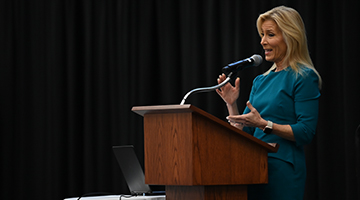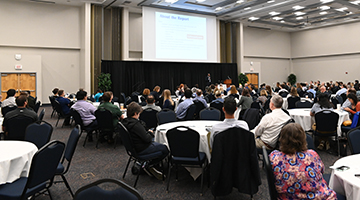2023 St. John’s River Report: Progress but growing causes for concern
 The 2023 St. Johns River Report, developed by an interdisciplinary team of researchers from the University of North Florida (UNF), Jacksonville University (JU) and other universities, will be released today, Friday, Oct. 13, at the annual Environmental Symposium. The research team will also discuss the findings during a virtual presentation and panel discussion hosted by WJCT Public Media at 4 p.m. on Monday, Oct. 16.
The 2023 St. Johns River Report, developed by an interdisciplinary team of researchers from the University of North Florida (UNF), Jacksonville University (JU) and other universities, will be released today, Friday, Oct. 13, at the annual Environmental Symposium. The research team will also discuss the findings during a virtual presentation and panel discussion hosted by WJCT Public Media at 4 p.m. on Monday, Oct. 16.
The City of Jacksonville Environmental Protection Board and UNF Institute of Environmental Research and Education annually host the Environmental Symposium to gather the best minds in environmental science and work toward solutions for the future.
This year’s report offers signs of some progress regarding the health of the river, although there are growing concerns in several areas. The River Report is an analysis of the health of the Lower St. Johns River Basin funded by the City of Jacksonville’s Environmental Protection Board. The report focuses on four main areas of the river: water quality, fisheries, aquatic life and contaminants.
The research team noted that the tributaries flowing into the St. Johns River continue to be badly polluted, especially with fecal bacteria, phosphorous and other materials. Wetlands also continue to be lost due to development, and the use of mitigation banks far outpace good alternatives like preservation, restoration and enhancement. Additionally, salinity has continued to increase, with effects on the ecology of the river and especially submerged aquatic vegetation. Finally, the water column is contaminated by pharmaceuticals, especially acetaminophen, ibuprofen and hydrocodone.
 There were some positive findings. Most fin fish and invertebrates are not in danger of overfishing. Protected species continue to fare well, despite recent storms and the effects on habitat.
There were some positive findings. Most fin fish and invertebrates are not in danger of overfishing. Protected species continue to fare well, despite recent storms and the effects on habitat.
This year’s report offers useful story maps on flood risk and social vulnerability and a variety of new maps in the Background section of the report. In addition, a Highlight section explores the “Past, Present, and Future of American Alligators.”
An interdisciplinary team of experts at UNF and JU contributed to this report.
From UNF, Dr. Christopher Baynard, associate professor of geography and geographic information systems, updated the historical background section (adding several new maps) and edited the report for the general public. Dr. Dale Casamatta, professor of biology, edited and updated the chapter on algal blooms. Dr. Scott Jones, assistant professor of biology, updated the chapter on water quality in the tributaries, while Dr. Adam Rosenblatt, assistant professor of biology, authored the Highlight section of the report this year that focuses on status of alligators in northeast Florida. Dr. Brian Zoellner, associate professor of teaching, learning & curriculum, served as co-principal investigator and helped JU students create presentations for secondary educators to teach their students about water quality, salinity, aquatic animals, invasive species and more. Dr. Charles Closmann, associate professor of history, created a new K-12 lesson plan on the history of the St. Johns River. UNF’s Center for Instruction and Research Technology (CIRT) staff including Shelby Scanlon, David Wilson and Mike Boyles provided valuable web support. Former UNF professor Dr. Radha Pyati, now chancellor and dean of Penn State Berks, wrote the executive summary of the report and the turbidity section.
At JU, Dr. Gerry Pinto served as principal investigator of the report, while also writing on salinity, fisheries and submerged aquatic vegetation. Dr. Gretchen Bielmyer-Fraser studied water quality and contaminants. Dr. Nisse Goldberg wrote about wetlands and non-native aquatic species. Dr. William Penwell wrote about bacteria. Dr. Ashley Johnson created a story map on flood risk, resiliency and social vulnerability, and assisted Goldberg with the creation of GIS maps of annual sanitary sewer overflows. Niki Spadaro provided important assistance as the technical editor of the entire report.
